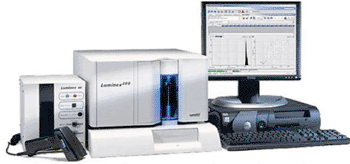HPV-Based Tests Warrant Longer Screening Intervals
By LabMedica International staff writers
Posted on 04 Feb 2014
The DNA test for human papillomavirus (HPV) allows for longer time between screening tests when compared to cytology-based testing.Posted on 04 Feb 2014
Cervical screening programs have until recently relied on cytology to identify women at risk for developing cervical cancer, but it has long been known that screening with HPV DNA tests has a higher sensitivity for cervical intraepithelial neoplasia (CIN).

Image: Luminex Multiplexing System (Photo courtesy of Luminex).
Scientists at the Karolinska Institutet (Stockholm, Sweden) enrolled 12,527 women aged 32 to 38 attending organized screening and randomized 6,257to HPV and cytology double testing, designated the intervention group, and 6,270 to cytology only, designated as the control group. Samples from the control group were frozen for future HPV testing. HPV DNA testing in the intervention group used polymerase chain reactions (PCR) with subsequent typing by reverse line dot blot hybridization. The types included in the HPV test were 16, 18, 31, 33, 35, 39, 45, 51, 52, 56, 58, 59, 66, and 68.
In the control group, the samples were frozen at −80 °C and retrieved for testing about 10 years later. HPV testing in the control group was based on the same testing principle but used improvements of the test that had been introduced in the meantime, namely, a switch to AmpliTaq Gold PCR enzyme (Life Technologies, Carlsbad, CA, USA) a modification of the general primers to increase sensitivity, and typing using Luminex technology (Austin, TX, USA).
At the follow-up 13 years after the start of the study, the scientists found that the increased detection rate for precancerous lesions of HPV-based screening reflects earlier detection rather than over-diagnosis. They also investigated the duration of the protective effect of the two screening methods by comparing overtime the incidence of precancerous lesions in women who had negative test results in the screening. They found that a negative test result in HPV screening is associated with a low risk for cervical intraepithelial neoplasia grade 2 or worse (CIN2+) or grade 3 or worse (CIN3+) and that this low risk is of prolonged duration.
The authors concluded that a five yearly screening interval for HPV negative women is an alternative to a three yearly screening interval for cytology negative women in those aged more than 30. The increased detection of CIN2 and CIN3+ during short-term follow-up of HPV based screening does not represent over diagnosis but rather early detection. This has important implications for the evaluation of the specificity and modelling of cost effectiveness of HPV based screening programs. The study was published on January 16, 2014, in the British Medical Journal (BMJ).
Related Links:
Karolinska Institutet
Life Technologies
Luminex














